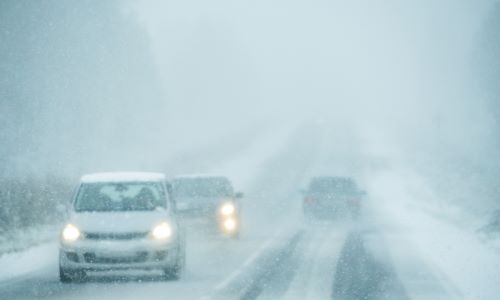Book a Consultation
Find out why so many clients appreciate the amount of work we put into their case.
"*" indicates required fields
Call 24/7

Driving in hazardous weather requires more than just basic skills; it demands a defensive approach that anticipates and mitigates risks. Rain, snow, fog, and high winds can turn routine trips into potential hazards, and understanding how to adapt to these conditions is critical.
This guide explores the science behind weather’s impact on driving, preparation techniques, defensive strategies, and emergency protocols to ensure your safety on the road.
Adverse weather significantly alters road conditions and vehicle performance. Wet roads increase the risk of hydroplaning as tires lose traction with the surface, while reduced visibility hampers a driver’s ability to react promptly.
Snow and ice create slippery conditions, with black ice posing particular dangers due to its near-invisible nature. Fog can obscure the road entirely, causing disorientation, and high winds destabilize vehicles, especially larger or lightweight ones.
These environmental factors slow reaction times, requiring drivers to be more attentive and cautious than usual. Defensive driving in such conditions emphasizes anticipation and preparedness for overreaction.
Proper vehicle maintenance is crucial. Tires should have adequate tread depth and be inflated to the manufacturer’s specifications.
Windshield wipers must be in good condition, and all lights should be functioning to ensure visibility. In colder climates, antifreeze and de-icing solutions are essential to keep systems running efficiently.
Check the weather forecast before heading out, and avoid driving during severe conditions if possible. Map out your route, keeping alternative paths in mind in case of road closures.
Notify someone of your travel plans and expected arrival time, especially in remote areas.
Utah’s diverse climate ranges from snowy mountain regions to arid deserts, requiring specific safety standards and regulations to address hazardous driving conditions. To satisfy these needs, the state emphasizes proactive measures to ensure public safety during inclement weather.
Utah law requires vehicles to be properly equipped for winter driving in snowy or icy conditions. From November 1 through March 31, vehicles traveling through certain mountainous areas must have traction devices, such as snow tires or chains, or be all-wheel-drive capable.
Law enforcement may stop and fine drivers who fail to comply with these requirements during hazardous conditions.
Utah’s “Basic Speed Rule” mandates that drivers adjust their speed based on road, weather, and visibility conditions, even if the posted speed limit is higher. This means slowing down significantly during rain, snow, or fog to maintain control of the vehicle and reduce the risk of accidents.
The Utah Department of Transportation (UDOT) recommends carrying emergency supplies, especially during winter months. Suggested items include blankets, flashlights, food, water, and jumper cables. During major weather events, UDOT often issues travel advisories and updates road closures in real time to keep drivers informed.
Utah prioritizes road safety through aggressive snow removal and road salting during winter storms. Drivers are encouraged to give snowplows a wide berth and avoid passing them unless absolutely necessary.
Plows are equipped to clear roads efficiently, but driving too closely can result in accidents or damage to vehicles.
Distracted driving is risky at all times but is particularly dangerous in adverse weather. Utah enforces strict laws against texting or using handheld devices while driving.
Drivers are urged to focus entirely on the road during poor conditions to avoid accidents caused by delayed reactions or inattention.
In Utah, accidents involving significant property damage, injuries, or fatalities must be reported to law enforcement. Drivers are required to move vehicles to the side of the road, if possible, to prevent further collisions in low-visibility conditions.
Driving in dangerous weather isn’t just about reaching your destination; it’s about doing so safely and responsibly. By preparing your vehicle, adopting defensive strategies, and knowing how to handle emergencies, you can reduce risks and maintain control even in the most challenging conditions.
Remember, the road may be unpredictable, but your readiness doesn’t have to be.
However, accidents can still happen despite taking every precaution. If you or a loved one are involved in a weather-related collision in Utah, Valley Law Accident and Injury Lawyers are here to help. Our experienced car accident lawyers are here to help every step of the way.
Our experienced team specializes in navigating the complexities of accident claims, ensuring you receive the support and compensation you deserve. Whether it’s dealing with insurance companies, determining liability, or understanding your legal options, Valley Law has your back.
Call us today at (801) 810-9999 for a free consultation, and let us help you focus on recovery while we handle the rest. Defensive driving keeps you safer, but when accidents occur, trust Valley Law to defend your rights.
Get in touch


2021 and 2022 Gold Winner for Top Law Firm by Salt City Best
Call 24/7 801-810-9999